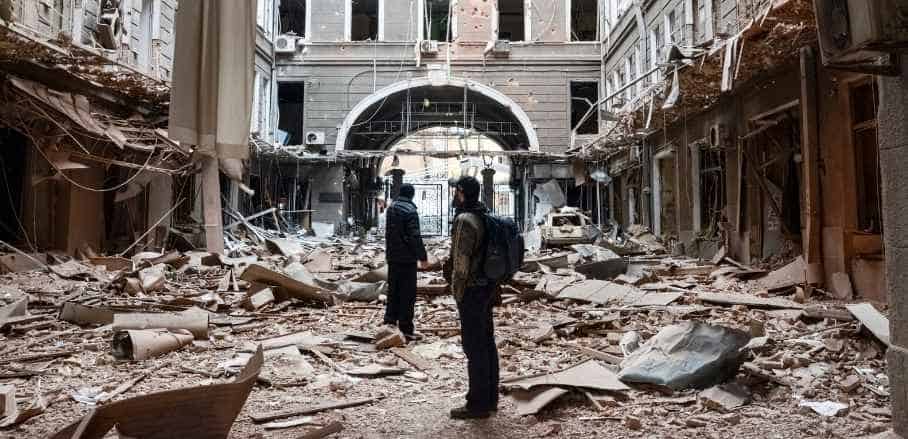From Ashes to Aspirations: Rebuilding Hope Amidst the War in Kharkiv
Kharkiv has been the first and among the most affected cities by the Russian attacks on Ukraine. How do you rebuild a city that is still at war? By Michelle Martin
The Russian war against Ukraine escalated in Saltivka. The northeastern district of Kharkiv was the first to be hit by Russian missiles on 24 February 2022. Saltivka is the biggest of Kharkiv’s nine city districts. Its huge, 15-stories apartment blocks made from prefabricated concrete slabs are typical for a socialist housing structure. Approximately 300.000 people used to live here.
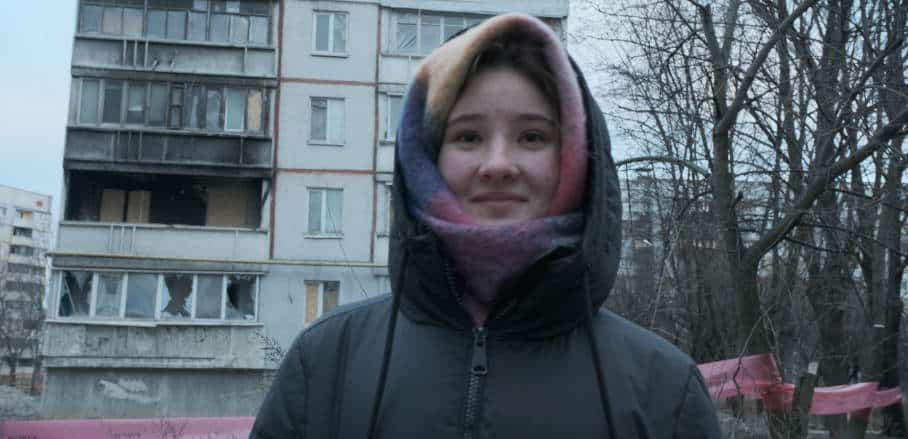
Julya visits her former neighbourhood, northern Saltivka. In the background, one can see one of the damaged buildings. © Mykola Shmundyr
One of them is Julya Shavrina, a 20-year-old former business student, who still remembers the day of the attack: “We woke up at 5 o’clock in the morning and missiles were hitting one of our military offices. We stayed at home for the next six hours because we did not understand what was happening.” Like many others, Julya and her family fled the city. It is estimated that just one month after the start of the Russian attacks on the Ukrainian mainland half of Kharkiv’s 1.5 million population had left already. 15 months later, approximately 1.2 million had returned. Though not to Saltivka – almost all its buildings have at least partially been damaged.
Due to its proximity to the border – Russia is merely 40 kilometres away – Kharkiv and the Kharkiv region have been and are still among the most affected within Ukraine. According to official figures, approximately 5,000 residential buildings in Kharkiv have been destroyed by the bombings, others speak of 6,500. “The damages are enormous in every respect, starting with the social and critical infrastructure and, of course, ending with the housing,” says Olga Demyanenko, adviser to the mayor for international cooperation and responsible for reconstruction measures. According to her, there is an enormous lack of accommodation: more than 150,000 inhabitants are currently homeless, and on top of the former residents, around 100,000 internally displaced people from the greater Kharvik region have also fled to the city. Despite further bombardments, people are starting to rebuild what’s left of their former homes and Kharkiv.
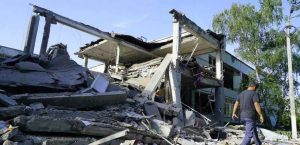
Due to the lack of accommodation, more than 150,000 inhabitants are currently homeless. © Partnerschaftsverein Charkiv – Nürnberg e. V.
How to Rebuild Under Fire?
Some buildings are just partially damaged, most windows are covered by clapboards. Others, like Julya’s, are completely destroyed. Though the city council works nonstop to clear the city from debris and to fix the roads, Julya is not happy. “My district is almost ruined: my university, my school, even my kindergarten.” She fears that Saltivka won’t be rebuilt – not during the war or even afterwards. Because it was already too heavily damaged, and the war is still going on.
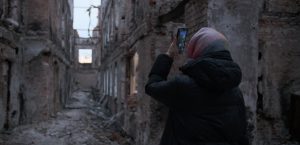
Julya visits her school, which is now completely destroyed – just like her home, university and kindergarten. © Mykola Shmundyr
But Kharkiv cannot wait until the war is over. Hospitals, roads, electricity, and water supply are needed now, says Olga Demyanenko, and she stresses the fact that the city equally prioritises housing and critical infrastructure. People cannot live without water and heating, especially given the upcoming winter, but they also need a roof above their heads. And you can neither rebuild hospitals nor housing if you lack the respective infrastructure – roads that enable the supply of resources, functioning bus and tram fleets for workers to get to the construction sites or energy supply.
To rebuild a city in the longer term, though, you need to decide whether to follow a pre-defined master plan or a rather incrementalist – a step-by-step – approach, says Dr. Anja Nelle, who works as an urbanologist for the sociological research institute Ifs Institut für Stadtforschung und Strukturpolitik in Berlin. An incrementalist approach refers to gradually making changes rather than through abrupt shifts or pursuing radical transformations. This can involve working with pilot projects under the premise of trial and error but also testing specific approaches in smaller, pre-defined territories.
New Beginnings
Regardless of the approach, the need for rebuilding offers the opportunity of building back better. Of not only reconstructing buildings, but doing so in a safe and secure manner, which under current circumstances involves the inclusion of bomb shelters. When Kharkiv was rebuilt the first time after World War II, energy consumption was not an issue. But given the climate crisis, it is today. That calls for energy-efficient buildings.
However, when assessing the sustainable reconstruction of damaged buildings, not only the current energy demand for operation should now be taken into account, but also the grey energy already bound up in the walls of the building. The so-called grey energy is the energy bundled in buildings that was used for construction, production, and transport. Thus, (re)building in a sustainable manner should refrain from associating old buildings with a bad reputation, such as that they cannot be managed sustainably and the often-antiquated construction methods lead to high energy consumption.
Another possibility would be to involve the citizens’ ideas in planning a new and improved Kharkiv through an integrative approach.
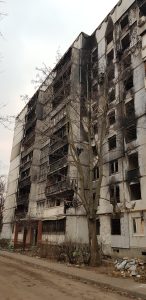
© Mykola Shmundyr
Building back better is the guiding principle for Maxim Rosenfeld and Olha Kleytman. The architects are part of the Kharkiv Group of Architects, a task force established by the United Nations Economic Commission for Europe (UNECE). The initiative focuses on the immediate and long-term reconstruction of Ukrainian cities, in this case, Kharkiv. UN4Kharkiv brings together multiple stakeholders including engineering firm Arup, the Kharkiv Group of Architects, and the Norman Foster Foundation led by renowned architect Norman Foster on a pro bono basis. The task force intends to develop a reconstruction master plan for Kharkiv developed through five core projects: heritage, rivers, industry, housing, and the science neighbourhood.
Balancing Vision and Reality
With regards to large housing estates – such as Julya’s – the housing project aims at retrofitting existing prefabricated concrete slab buildings to generate safe, modern, and energy-efficient housing across the city. Before the war, these buildings constituted up to 80 per cent of Kharkiv’s residential areas. With 70 per cent of the energy generated from coal, gas, and oil they were far from being energy efficient. “We need to be more effective in terms of rebuilding and using what we already have”, says Olha Kleytman from the project. But Olga Demyanenko and the city council pursue a more practical approach: “We save what we can save. We need to rebuild everything very quickly, but new technologies and projects take a very long time to design, to work on.” Evidently, Kharkiv’s reconstruction is a balancing act: between rebuilding quickly and rebuilding energy efficient, between implementing emergency measures and long-term solutions, between retrofitting the old and envisioning the new.

Kharkiv’s Regional State Administration © Partnerschaftsverein Charkiv – Nürnberg e. V.
Until now, the city has rebuilt 250 of the prefabricated concrete slab buildings. Julya’s building was not among them. “As for my apartment, there is no information. Also, with regard to Saltivka, a lot of questions remain. We have no guarantees that the buildings keep standing because when it is winter they will become more unstable with time due to the cold. Eventually, the buildings might not be considered a subject to repair measures anymore,” the young woman worries.
More Commitment Needed for Integrative Approach
If asked, Julya would opt for Saltivka to be rebuilt. She still considers the district her home. But citizens’ participation – asking Julya – remains an unanswered question. Although the city showed some initiative in integrating people’s opinions and ideas by distributing a questionnaire on living conditions (which received 17,000 responses), experts within the academic community that are involved in the planning process criticise the lack of transparency and communication. This coincides with Julya’s account: “Officially, there is no information on who, when and where the rebuilding is going on. There are no guarantees right now regarding financial support to residents who lost their homes.” However, as the first open dialogue in August brought together representatives of the city, architects, and citizens, there is hope that participation will be strengthened further.
“If my district were a person, …” © Mykola Shmundyr
No matter how the situation develops, Julya plans to stay in Kharkiv. She wants to help her parents rebuild their apartment and start anew, because “understanding that it is gone, is difficult. But then you start to see your whole life completely new, and you start to see new opportunities, new desires, and hope. You understand that what matters is not material, but emotional stability, humanity, and people.”
- From Ashes to Aspirations: Rebuilding Hope Amidst the War in Kharkiv - 31. August 2023
